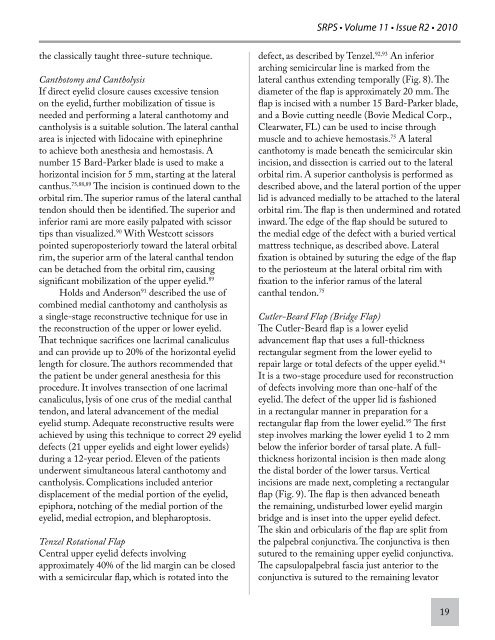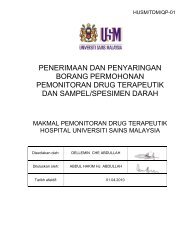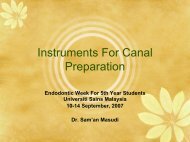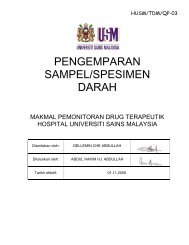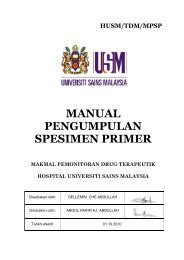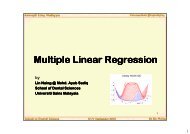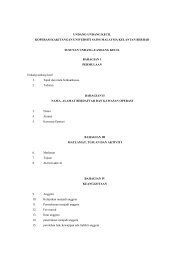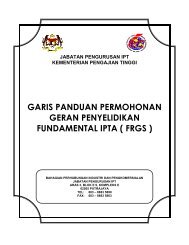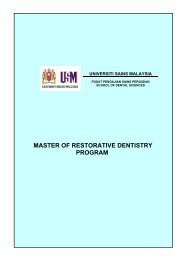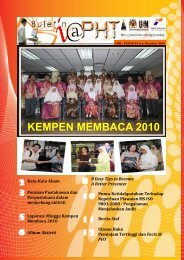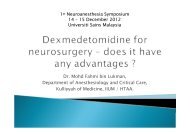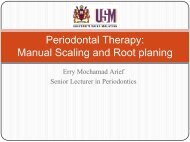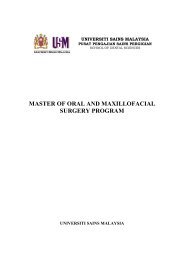Vol 11-R2- Eyelid
Vol 11-R2- Eyelid
Vol 11-R2- Eyelid
Create successful ePaper yourself
Turn your PDF publications into a flip-book with our unique Google optimized e-Paper software.
the classically taught three-suture technique.<br />
Canthotomy and Cantholysis<br />
If direct eyelid closure causes excessive tension<br />
on the eyelid, further mobilization of tissue is<br />
needed and performing a lateral canthotomy and<br />
cantholysis is a suitable solution. The lateral canthal<br />
area is injected with lidocaine with epinephrine<br />
to achieve both anesthesia and hemostasis. A<br />
number 15 Bard-Parker blade is used to make a<br />
horizontal incision for 5 mm, starting at the lateral<br />
canthus. 75,88,89 The incision is continued down to the<br />
orbital rim. The superior ramus of the lateral canthal<br />
tendon should then be identified. The superior and<br />
inferior rami are more easily palpated with scissor<br />
tips than visualized. 90 With Westcott scissors<br />
pointed superoposteriorly toward the lateral orbital<br />
rim, the superior arm of the lateral canthal tendon<br />
can be detached from the orbital rim, causing<br />
significant mobilization of the upper eyelid. 89<br />
Holds and Anderson 91 described the use of<br />
combined medial canthotomy and cantholysis as<br />
a single-stage reconstructive technique for use in<br />
the reconstruction of the upper or lower eyelid.<br />
That technique sacrifices one lacrimal canaliculus<br />
and can provide up to 20% of the horizontal eyelid<br />
length for closure. The authors recommended that<br />
the patient be under general anesthesia for this<br />
procedure. It involves transection of one lacrimal<br />
canaliculus, lysis of one crus of the medial canthal<br />
tendon, and lateral advancement of the medial<br />
eyelid stump. Adequate reconstructive results were<br />
achieved by using this technique to correct 29 eyelid<br />
defects (21 upper eyelids and eight lower eyelids)<br />
during a 12-year period. Eleven of the patients<br />
underwent simultaneous lateral canthotomy and<br />
cantholysis. Complications included anterior<br />
displacement of the medial portion of the eyelid,<br />
epiphora, notching of the medial portion of the<br />
eyelid, medial ectropion, and blepharoptosis.<br />
Tenzel Rotational Flap<br />
Central upper eyelid defects involving<br />
approximately 40% of the lid margin can be closed<br />
with a semicircular flap, which is rotated into the<br />
SRPS • <strong>Vol</strong>ume <strong>11</strong> • Issue <strong>R2</strong> • 2010<br />
defect, as described by Tenzel. 92,93 An inferior<br />
arching semicircular line is marked from the<br />
lateral canthus extending temporally (Fig. 8). The<br />
diameter of the flap is approximately 20 mm. The<br />
flap is incised with a number 15 Bard-Parker blade,<br />
and a Bovie cutting needle (Bovie Medical Corp.,<br />
Clearwater, FL) can be used to incise through<br />
muscle and to achieve hemostasis. 75 A lateral<br />
canthotomy is made beneath the semicircular skin<br />
incision, and dissection is carried out to the lateral<br />
orbital rim. A superior cantholysis is performed as<br />
described above, and the lateral portion of the upper<br />
lid is advanced medially to be attached to the lateral<br />
orbital rim. The flap is then undermined and rotated<br />
inward. The edge of the flap should be sutured to<br />
the medial edge of the defect with a buried vertical<br />
mattress technique, as described above. Lateral<br />
fixation is obtained by suturing the edge of the flap<br />
to the periosteum at the lateral orbital rim with<br />
fixation to the inferior ramus of the lateral<br />
canthal tendon. 75<br />
Cutler-Beard Flap (Bridge Flap)<br />
The Cutler-Beard flap is a lower eyelid<br />
advancement flap that uses a full-thickness<br />
rectangular segment from the lower eyelid to<br />
repair large or total defects of the upper eyelid. 94<br />
It is a two-stage procedure used for reconstruction<br />
of defects involving more than one-half of the<br />
eyelid. The defect of the upper lid is fashioned<br />
in a rectangular manner in preparation for a<br />
rectangular flap from the lower eyelid. 95 The first<br />
step involves marking the lower eyelid 1 to 2 mm<br />
below the inferior border of tarsal plate. A fullthickness<br />
horizontal incision is then made along<br />
the distal border of the lower tarsus. Vertical<br />
incisions are made next, completing a rectangular<br />
flap (Fig. 9). The flap is then advanced beneath<br />
the remaining, undisturbed lower eyelid margin<br />
bridge and is inset into the upper eyelid defect.<br />
The skin and orbicularis of the flap are split from<br />
the palpebral conjunctiva. The conjunctiva is then<br />
sutured to the remaining upper eyelid conjunctiva.<br />
The capsulopalpebral fascia just anterior to the<br />
conjunctiva is sutured to the remaining levator<br />
19


